I have a lot of people ask me if it is worth it to buy organic cotton clothes. What about used clothing that isn’t organic? Then there is hemp, bamboo, soy, and wool. There are so many options it can get confusing. Then throw in there the types of dyes, and other toxic chemicals, that are used that potentially can make your organic clothing toxic and it gets really confusing. So let’s dig in and see if organic clothing is worth buying!
I’ve been doing a lot of research on this, talking to fabric manufacturers, emailing with companies, and reading up on everything from fibers to processing to manufacturing.
I’ve dug deep on certifications of raw cotton, fabrics, and final pieces that clothing can have. Unfortunately, I now know more than I wish I did! I will never look at clothing the same.
First I’ll go over the environmental and social aspects of each of the types of fabrics, then some information on dyes, then the certifications, and finally my opinion if buying organic is worth it.
The reason this is so important is that your skin is your largest organ. Everything you put on it gets absorbed into your bloodstream.
If you don’t want to read all of this you can skip to the bottom for the link to the list of recommended clothing companies (but I do recommend reading this so you are an educated consumer!).
This post may contain affiliate links. Please see my full disclosure policy for details.
Quick Navigation
Clothing Fiber Types
Conventional Cotton (Non-Organic):
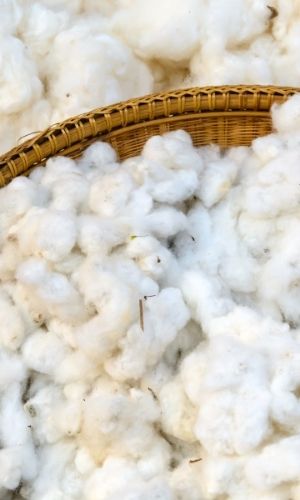
- For every 1 pound of cotton produced, about 1/3 of a pound of chemical pesticides and fertilizers are used. Just to give you an idea of how much cotton that is, it takes just under 1 pound of raw cotton to make a t-shirt.
- 16% of the world’s pesticides are used on cotton crops where only 2.5% of the world’s land is cotton fields. Cotton is the most pesticide-intensive crop grown on the planet. $2.6 billion worth of pesticides are used on cotton worldwide each year. That is a huge percentage of toxic chemicals used to grow conventional cotton! Think of the overspray, which can travel up to 2 miles, that is in the air (that you breath) and getting on other crops (your food) just from cotton.
- The Environmental Protection Agency considers 7 of the 15 pesticides used on conventional cotton as possible or known carcinogenic (cancer-causing) agents.
- Cotton is considered the world’s dirtiest crop due to its heavy use of insecticides, the most hazardous pesticide to human and animal health.
- According to the World Health Organization, 20,000 people die every year from accidental pesticide positioning in conventional cotton agriculture, and 1,000,000 people a year suffer from long-term pesticide positioning (Pesticide Action Network).
- 100 million conventional cotton farmers, from Russia to South Africa, are living in conditions of abject poverty and near starvation. Conventional cotton subsidies (funded by American taxpayers) are causing poverty in the developing world as they lower the world price for cotton.
- Cotton is an extremely water-intensive crop
- Most conventional cotton being grown is now GMO cotton a whole other post could be written about GMOs!
- Most cotton clothing is now being produced in China in sweatshops where women & children are being exploited and are working well below the minimum wage. How do you feel about your new shirt or pants when you think a child might have made it? Looking for clothes not made in China is a big challenge too. I’ve found several companies that I will share with you.
- Sadly, the suicide rate for conventional cotton farmers is high (especially in India). Some say it is no higher than it always has been. Some say it is higher now that cotton farming is GMO. Either way, it is a sad situation.
Organic Cotton:

- No pesticides, fertilizers, or other chemicals are used when growing organic cotton
- To be certified organic the soil must be free from chemicals for at least 3 years
- The land, and soil, benefits from crop rotation
- Cotton is an extremely water-intensive crop
- A lot of organic cotton is grown in other countries so it requires shipping to the US. However, there are several states in the US that grow organic cotton.
- Look for the GOTS certification to make sure the clothing is organic and non-toxic from field to finish. You can buy organic cotton, that is not certified, that has been finished with toxic dyes or chemicals (I find this very sad but it is true).
Hemp:
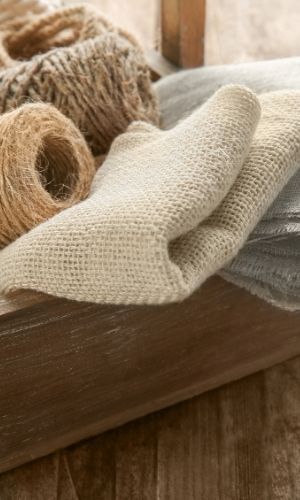
- No pesticides, fertilizers or other chemicals are needed to grow hemp
- The traditional way to get to the hemp fiber in Europe is to leave the stalks out in the fields and have the weather brake the stalks down. Then the farmers can harvest the hemp. In China, some of the farmers are now using chemicals to break down the hemp stalks to speed up the process of harvesting. This is very sad that such a great, natural fiber, is having chemicals added to it for no reason other than speeding up the harvesting time. Another reason to avoid things made in China!
Bamboo:
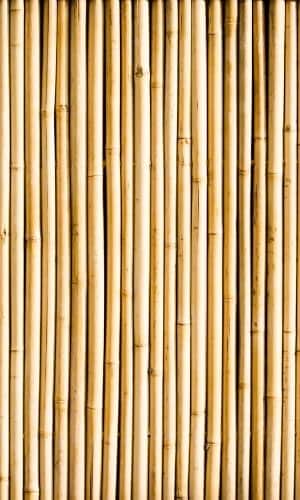
- Is being touted as a “green” material. It is true that it is hearty, grows very easily, and can be cultivated quickly. From that standpoint, it is green.
- Getting bamboo into a usable form can be a very chemically invasive process that uses harsh chemicals. Bamboo must go through several chemical processes to get into a usable form. The human exposure to toxins and damage to the environment surrounding the factories make bamboo not as green as everyone is saying it is.
- Most all fabric and clothing that is bamboo, is bamboo rayon or bamboo cellulose, which is made using the chemically intensive process described above.
- Bamboo linen is generally made without the use of chemicals but since it is such a labor-intensive process there is very little bamboo linen on the market.
- Very little water is needed to grow Bamboo
- Raw bamboo lets most UV rays through the clothing (unlike cotton) and there have been talks about adding chemicals to the clothing for UV protection.
- Bamboo is very soft which makes it appealing for clothing.
Soy:

- Soy is one of the largest GMO crops worldwide.
- It requires a lot of water and pesticides to grow.
- Soy is biodegradable and has minimal impact on the environment – non-GMO, organic soy that is!
- Soy fiber is not as durable as cotton or hemp
- Soy fiber is made from the byproduct of the soy industry (tofu, soybeans, etc) so it is not grown specifically for clothing. It’s nice that it is a dual purpose.
- The process to turn soy into clothing is a very chemically intensive process. The same chemicals are used repeatedly so at least chemicals aren’t be dumped as often. However, those chemicals are still being applied to the clothing you will be wearing.
Wool:
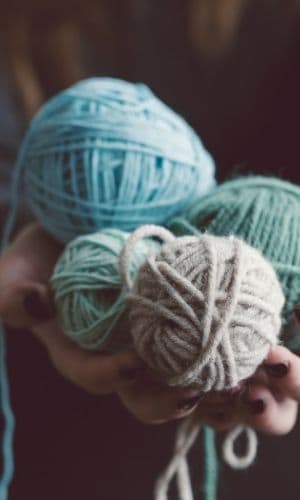
- Wool is a great renewable fiber.
- Wool keeps you warm in the cold months and cool in the warm months.
- Wool is naturally flame resistant.
- It tends to be both dust mite and mold resistant.
- Wool is lightweight.
- Lower quality wool can be itchy but most wool is not itchy at all.
- Some people can be allergic to wool. In most cases, it is very rare for someone to be allergic to organic wool. Most people have a reaction to what the wool was treated with if it wasn’t organic.
- There can be inhumane practices associated with wool, like mulesing, in Merino wool. Mulesing is cutting out strips of skin near the sheep’s rear to prevent pests, some places will kill a sheep for the wool and some sheep farmers pack in the sheep like you would see on a factory farm. If you Google mulesing just be prepared to see some grotesque and upsetting pictures. I would say that these practices aren’t the norm, and if you look for certified wool you won’t have to worry about contributing to inhumane practices.
- Sheep can be sprayed with pesticides.
- Organic wool and Zque certified wool do not allow inhumane practices (like the ones mentioned above) or pesticides to be used. Another reason to buy organic!
Synthetic fibers:
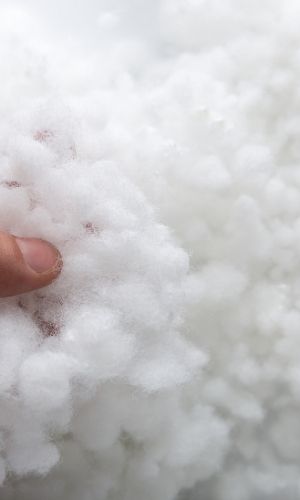
- Synthetic fibers are a petroleum (i.e., oil) by-product. Synthetic fibers have been linked to many health issues, including cancer. Also, they release microplastics in your home (which you then breathe) and into the waterways polluting the earth. Avoid synthetics!
Common Chemicals, and Toxic Dyes, in Conventional Clothing:
- Formaldehyde. This keeps clothing from becoming wrinkled during shipment and prevents mildew. It also increases stain resistance and is used for color fasting. It is a known carcinogen. The US does not regulate formaldehyde in clothing.
- Nonylphenol ethoxylate (NPE). This chemical is very toxic and is banned from being used, except for some factories in China and Southeast Asia. This has hormone-disrupting properties and can be hazardous at low levels. 14 major brands in the USA have their clothing made in factories that use NPE. From what I could find, these companies had clothing that was tested to have NPEs – Calvin Klein, Abercrombie & Fitch, Adidas, Ralph Lauren, Nike, Puma, and H&M. Another reason to not buy clothing made in China!
- Perfluorinated chemicals (PFCs). This makes clothes wrinkle-free or no iron. This is the same chemical used in Teflon and is known as a forever chemical (because it never breaks down). It is used a lot of times to make clothing water repellant, like outerwear. This chemical has been linked to cancer and kidney disease.
- AZO dyes use heavy metals, including lead. They are extremely toxic and are still used in clothing made in China. The use of AZO dyes has been banned in the USA, but they are still imported.
- There are many other chemicals in clothing, including phthalates, which are very toxic. Let’s discuss ways to protect your family.
Clothing Certifications:

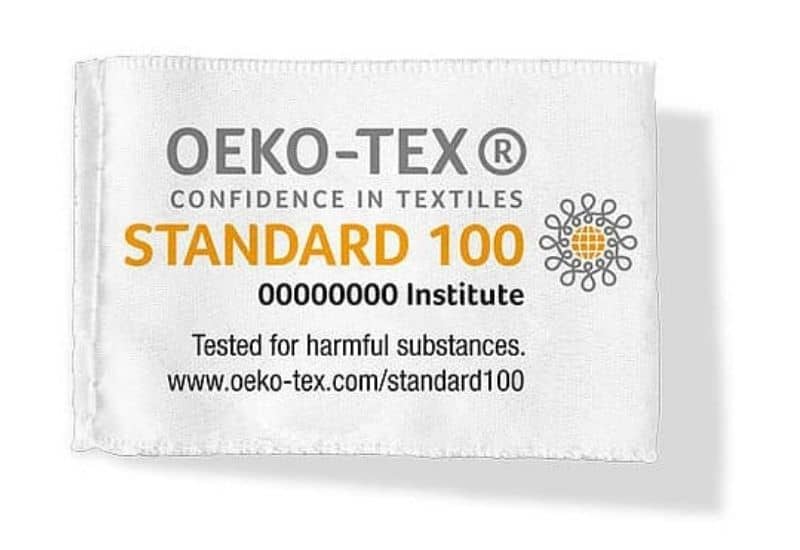
- GOTS – Global Organic Textile Standard – is the leading certification for organic, non-toxic fibers and clothing. This certification is the most stringent certification for clothing. No flame retardants are allowed, no AZO dyes using heavy metals, no formaldehyde, no pesticides, no phthalates, no PVC, no PFCs, no NPEs, no chlorine bleach to list a few. There is also a social aspect to it as well, employees must have fair working conditions and be paid a fair wage. There can be no animal cruelty. It really is the best certification out there. Pretty much all GOTS certified clothing will have a logo on the inside of the clothing stating it is GOTS certified. You can have GOTS certified organic cotton but if the final product wasn’t produced in a GOTS certified factory then that company is not allowed to use the GOTS logo. When you see the logo you can be rest assured that the entire product is GOTS certified.
- Oeko-Tex – is a certification that doesn’t allow hundreds of toxic chemicals in clothing. Clothing does not need to be organic to receive this certification (pesticides are allowed to be present on clothing to pass this certification) Also, some chemicals, like flame retardants (that are deemed to be the least toxic), are allowed to be used. If you are buying Oeko-Tex clothing or baby products check to see if they are using flame retardants.
For additional details and other certifications please read my post on Clothing Certifications.
So, What Should I Buy?
GOTS certified organic cotton or wool is the best, and safest, clothing to buy. I found out early on that just buying organic cotton doesn’t mean that the safest dyes or no toxic chemicals are being used.
The organic clothing industry is growing by leaps and bounds and some companies are trying to cash in by using organic cotton but not truly making an “organic” piece of clothing. I also buy organic cotton that is Oeko-Tex certified but it is my second choice. Currently, I just buy Oeko-Tex organic pajamas for my son.
If I can buy used GOTS certified clothing I do. However, I’m picky about it. I’ve purchased a few things on eBay only to have them reek of laundry detergent or dryer sheets that have toxic chemicals. Side note – wash your clothing in non-toxic laundry detergent. Most commercial brands are toxic! I felt like buying used, washed in chemicals, defeated my purpose. So I’m specific when I buy used, so specific that I started a Natural Baby Mama buy/sell/trade group on Facebook only for natural and organic items!
I know not everyone wants to buy new organic clothing. The order I would buy clothes in is:
- Used GOTS certified organic (cotton or wool) clothing
- New GOTS certified organic (cotton or wool) clothing
- Used or new hemp, verifying if it’s organic would be ideal, clothing
- Used conventional cotton clothing. Side note – I personally would try and buy Oeko-Tex certified used cotton first before buying non-certified conventional cotton. At least then you will know that the dying and finishing process isn’t toxic. However, pesticide residue and flame retardants are allowed in the Oeko-Tex certification.
Doesn’t Washing Your Clothes Wash Away the Chemicals?
Maybe some but there is no way to know. Some toxins do wash other, others are designed to last the life of the product. I have read reports that it can take 50 washes to get all the chemicals out.
Regardless, you should wash all clothing before wearing it. Even GOTS certified. One issue I have with buying used non-certified clothing is you don’t know if it’s been washed once or 50 times. If it’s toxic to start with you aren’t guaranteed buying used will make it any less toxic. Buying used is no doubt good for the environment.
Are There Children’s Clothing Brands That I Avoid?
Some of the worst brands from a toxicity standpoint that I wouldn’t buy (even used) are:
- The Gap / Baby Gap
- Old Navy
- J. Crew
- Disney
- American Apparel (they do make GOTS certified organic clothing so that would not apply)
- Burberry
- Nike
- Adidas
- Puma
One thing all of these companies have in common is that the clothing is made in China (except American Appeal). Toxic clothing is coming out of China.
Further Reading on Organic Cotton Clothing:
- Organic Children’s Clothes – babies & kids
- Organic Clothing for Adults
- Organic Sheets
- Organic Clothing Certifications – all the details you need to know
- Fast Fashion and Environmental Impacts
- Organic New Born Baby Clothes
- Sustainable Fashion
- Slow Fashion
- Non Toxic Deodorants
Pin it for later!
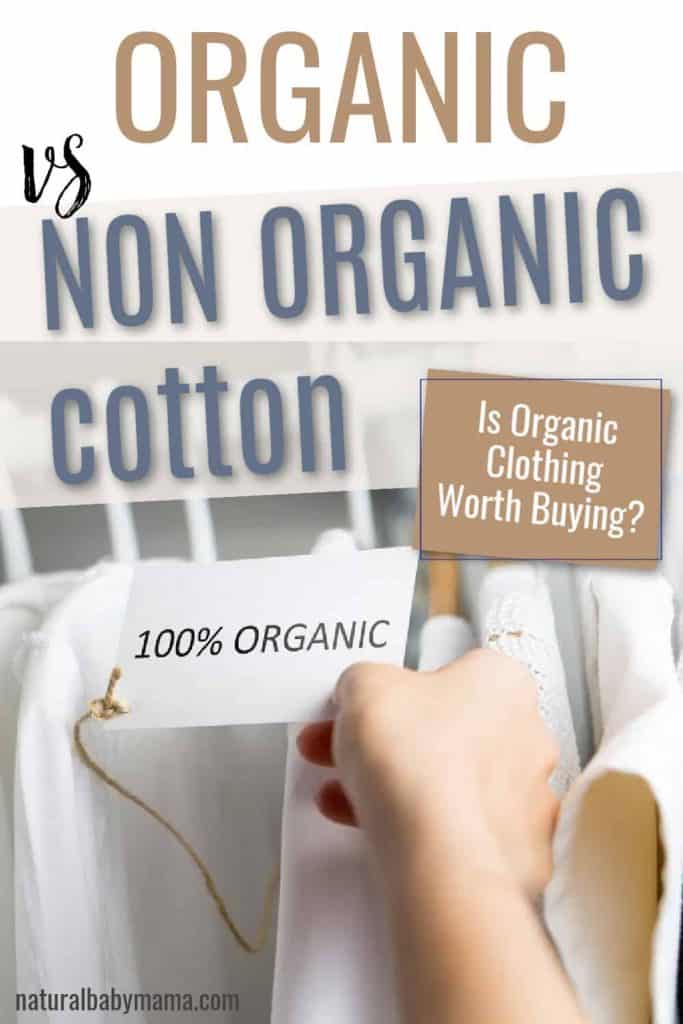




Thanks so much for sharing your research here. I found your blog while looking for the healthiest car seat (a daunting task, as you know, any update there??). Anyway, a few questions on the subject of clothing – both the Disney Store and Gap have limited organic cotton selections, are they just bad on principle? Or do they use toxic dyes? Also, how do you deal with gifts that don’t meet your standards? My daughter is 4 so there’s not a lot of rational discussion about the stuff that is gifted to us
I wish I had an update on the car seat issue. I would probably recommend Nuna Pipa for the infant seat and Clek for toddler or booster.
The issue with the Gap and Disney is that they are both known for using toxic chemicals in their clothing. Just because they have organic clothing doesn’t mean it is really organic. They use organic cotton but I’m sure are dying, processing and finishing it with chemicals the exact same way as their non-organic clothing. For example, my pottery barn organic sheets had formaldehyde in them. The only way to know for sure what you are getting is to buy certified.
My family knows I’m super specific so we rarely get clothes or toys outside of the companies I like. That being said, we occasionally do. I generally try to sell them on a mom’s group or craigslist if I’m not going to use them. Sometimes I just gift them to friends who know that I care about products but they might not care. This last year we set up an amazon gift wish list for my son and let family know about it.
Thank you!!! I’ve been researching this myself too to make sure organic GOTS clothing is definitely worth it, especially since it’s more expensive than just regular cotton and even organic cotton. This write-up is perfect timing for me!
Good, I’m glad! It is more expensive but there are always sales. Also, we don’t buy a ton of clothes and I generally buy a size up and roll up the sleeves or pant legs. My son has literally worn 1 pair of jeans for over a year and a half which is an eternity in kids clothing! I’m sure I have way less clothing for him than most people but at least it’s all non-toxic!
Oh that’s a good tip about sizing up! You’re right though. Kids don’t necessarily need a ton of clothes, and yes, there are always sales. I just bought some stuff from Under the Nile that was 50% off, along with a 20% off coupon for Memorial Day. Score!
Sweet deal! Sometimes when there are really good deals I buy multiple sizes up. I literally just bought a pair of jeans for my son that were 3 sizes too big. Kinda crazy but they were like 60% off!
Thanks for your response. Gifts are tricky right? I’m especially mindful now when choosing things for others, so maybe that will get the message across? 😉 we donate a lot.
One more question, do you know anything about the new Burt’s bees line of clothing, towels etc? It’s labeled “certified organic” but seems vague. It’s also very inexpensive, relatively speaking.
I wondered about this Burt’s Bees too actually. I have a couple of organic cotton onesies that I received and washed. They definitely wrinkled so that made me think they weren’t treated with formaldehyde, but I’m not sure about the dyes used.
I actually called them awhile ago because I was given a Burt’s Bees organic shirt. I asked if they were GOTS certified and it was a vague answer. Maybe I’ll call again because I think I remember the answer being that they are working on getting certified but they currently weren’t. She actually answered yes but then I asked why the GOTS logo wasn’t on the shirt and then she started backtracking. I can’t remember the full conversation though. I’ll update when I call them back. Also, Burt’s is now owned by Clorox – not sure if you knew that or not.
Gifts are super tricky, it’s really hard when you know people are trying so hard too.
Just wondering if you ever got a response from Burt’s Bees about their organic baby clothing? It would be nice if they were safe considering how much $$$ organic clothes can be!
I haven’t but will try again!
Burt’s bees is listed on the GOTS website.
Hey there– what about GOTs certified nursing clothes for mama? I’m trying to find some nursing tanks/pjs/robes and I’ve spent a ridiculous amount of time researching without finding a solid brand. So many companies like Ecoland, Majamas, Pure Fabric etc all *seem* great they all say ‘certified organic’ but no one as of yet has been able to give me a GOTs certificate, and none of them can be found in the GOTs public database, ahhh! After spending a fortune on the stupid Orbit, I feel like I can’t buy anything without a certificate.
Any idea of where I can buy truly certified mama clothes? I just feel like if baby is going to be eating from me, I should be a bit more careful on the clothes I wear too!
THANK YOU
Funny, I’ve been looking high and low for this type of clothing too. I went to a local maternity store that use to sell organic maternity & nursing clothes and they told me that a lot of the companies that made those organic clothes no longer are. With that being said I had bought a nursing top at that store from Blue Canoe who is GOTS certified. Looking at the site it would have just been a regular top that crosses in the front. PACT is GOTS certified but they don’t have specific nursing clothes. Little Spruce Organics has organic, GOTS certified nursing bras and they might carry some limited PJs now. Finding GOTS certified clothes is so much harder for adults. Sometimes businesses do business as another name on the GOTS certified. For example, Kate Quinn sent me their GOTS certificate but it was a different name and that might be because they have several different clothing lines. Also, maybe try Etsy. You might just need to go with undyed, organic cotton? If I find anything more I’ll send it to you.
Thank you! Just realizing I didn’t say thank you earlier! P.S. I find your blog to be the most helpful, normal and down to earth of all. Would love more posts of what you have found out.
Great list! There were a couple I didn’t know about. It was such a challenge for me to find organic baby clothes when my baby was an infant. Her attire consisted of a wool diaper cover and kimono tops with onsies. I was disappointed there weren’t more options…and if there were, I had the hardest time finding the. Now, there are at least a dozen places to find organic clothing and it’s amazing! Have you heard of Broken Tricycle? They’re a fair trade organic children’s clothing company based out of Australia. Nosilla Organics is another excellent quality clothing company. We also like Hanna for pi’s – even I own some of their women’s PJ’s 🙂
I’m making a blanket for my son using GOTS cottons and batting, thanks to reading this post. I tried getting an organic sateen binding for the edge, but it’s not only rough, it’s also missing the creases that make binding easier to work with. I’m searching for a binding and would prefer a satiny one, since I know that’s often something babies seek out, but I don’t think that’s possible with a natural fiber. I’m thinking I’d go with polyester for that part as long as I could find one without the toxic dyes and chemicals. Do you know of any certification for non-organic clothing/material that would ensure it’s free of dangerous dyes and other added chemicals?
Oeko-Tek certifies non organic material so maybe look for that. Personally I would try and stick to a natural fiber, organic cotton or wool, since that is the part that they are going to put in their mouth. What about organic cotton fleece? It’s super soft. I think just have two different textures would be nice.
How did you find out your Pottery Barn sheets had formaldehyde in them? My son has some organic Oeko-Tek certified sheets. After reading your post, I contacted PB and they said there was no formaldehyde in the sheets. But I do remember when I got them they were pretty wrinkle free.
My sheets were organic and later I found out wrinkle free. They told me that they were but wouldn’t confirm the chemical used. I was working with someone who is very knowledgeable in the textile and green industry and she said she was finally able to get to the bottom of it with Pottery Barn about a year ago. My sheets weren’t Oeko-Tek certified. Some chemicals, and FRs, are allowed within Oeko-Tek. I can’t remember if formaldehyde is allowed in Oeko-Tek, I think that it’s not though. At the time I talked to Pottery Barn in 2012 they definitely had organic sheets that weren’t treated to make them wrinkle free. It was just the start of me not trusting something just because it was organic 🙂
Any more word on Burts Bees? I have a ton of kohls cash to use and they sell Burts Bees. Also, anyone have a comment on Targets organic sheets? I currently sleep on them and I’m 5 months pregnant.
Burts Bees is now GOTS certified. Before they weren’t. Do you know if the sheets are GOTS certified? If they are, they are fine 🙂
No there’s nothing on the tag saying the sheets are 🙁 Great news on the Burts bees when kohls has sales the clothing is very reasonably priced.
You could always call Target and ask. There are times where things are GOTS certified but aren’t labeled. Most of the time they are labeled though.
Do you know the exact time when they became GOTS Certified?
I don’t, but if you email them they should have an answer. You can also look on the GOTS website to see if it lists the date.
Just a comment regarding bamboo. We bought some Nandina Organics bamboo towels. They are incredibly soft, and also they truly are mildew resistant (we have a damp bathroom with poor ventilation and have had issues with regular towels). Your comments on bamboo were interesting though, and made us double check these. The Nandina towers are GOTS certified and carry that logo on their label, so I think we’re in the clear, right?
By the way, they were quite pricey, but worth it.
The GOTS certification means that it was grown organically and that no harmful chemicals were used. I’m not familiar with this brand but I did a quick look. It looks like they have an organic cotton & bamboo blend towel? If you are concerned I would just call and confirm that the finished product of the towel is GOTS certified not just the unfinished fiber. With that being said it looks like they are a pretty aware / natural company.
Thank you so much for this wonderful blog! It’s been incredibly helpful in so many different ways! I have been trying to weed out toxic clothes little by little and have purchased some clothes (not organic but Oeko-Tek certified) and pajamas (organic and Oeko-Tek certified) from Hanna Andersson. I was just wondering if you know anything about their products and whether they use any toxic substances such as flame retardants, pesticide residue or toxic dyes in the finishing process. Thanks!
I like Hanna Andersson PJs – they are organic and Oeko-Tek certified. Hanna does not use FRs in their PJs. As far as pesticide residue on their non organic clothes – that’s hard to tell because Oeko-Tek allows for conventional cotton which uses pesticides and is one of the largest GMO crops in the world. So my thoughts are that the residue is there. I still with organic when possible.
Loved the read, very informative. I do have one question however, do you have any information on what happens once you get these products home, organic or not and wash them with detergent? I know lots of people use homemade laundry soaps or eco friendly, however I’m considering cloth diapering and have read that homemade detergent is a no go, and that regular TIDE powder is the best to get them clean. I have seen lots of diapers from WAHM using Bamboo or Organic fabrics and i was just wondering what the effects of using TIDE then does?
Honestly using Tide on anything in my home would be a no go. I cloth diaper and have never used Tide. You can look up detergents on EWG Skin Deep to know what you are putting on your skin or washing your clothing with. I would suggest doing that with TIDE.
Fluff love university is a great website all about cloth diapers. I had an extremely hard time finding a detergent that was safe for cloth that I was comfortable with. I ended up selecting Seventh Generation ultra power plus & have been very happy with it.
But I’m curious Natural Baby Mama.. have you tried it? I’d love to hear your thoughts. This was the only one I could find that was unscented, plant based, etc.
I never bought a separate detergent for cloth diapers. It’s just whatever we were using at the time. I used EcoNuts for many years with cloth diapers successfully.
Awesome info! Thanks for doing the work for us. Xo
I have three sons ages 10,12,and 14. I just purchased Adidas Hi Tops and I just find found your list with Adidas on it. I do not Facebook. So I am unable to go to your closed group and post.Do you think they are safe to by now ? I just learned my 10 yr old has been wearing Bog boots for 2 yrs now and they have lead in them. YIKES 🙁
I was looking to know more about organic clothing. It is good to know that organic cotton is good for children because there are no pesticides, fertilizers, or other chemicals used when growing this cotton. It would be great to find how to properly care for organic clothing to keep it in good condition for as long as possible.
I just wash it normally and it holds up the same 🙂
What is your opinion about Carters?
Hi, I talk about Carter’s organic line in this post. It’s number 28 https://naturalbabymama.com/organic-clothing-for-kids/
I had just been reading on GOTS certification. This was very useful in further understanding
I just recently came across your blog while researching enamel pans. So glad I did! I am loving it so far. Thanks for sharing all your experiments and great information! Looking forward to reading more. And I will definitely check our your Amazon recommendations!
I have some concerns about organic wool I thought you might be interested in, and am curious to hear what you think. While it may possibly be a better option than convention wool in some ways, I don’t think it’s the best option. At least if you’re concerned about animal welfare or the environment. There is no such thing as humane wool. For example:
Wild sheep will naturally shed their winter coat. But ALL domesticated sheep have been bred to produce an unnatural, excessive amount of wool. It becomes quite uncomfortable and can cause health issues. So, they have to be sheared. They don’t like it, so they must be restrained. Shearing happens fast.. maybe only 2 minutes to shear an entire sheep. So sheep are nicked, cut and bruised in the process. Tail docking may still happen.
Raising sheep and processing the wool wastes an insane amount of water. Then there’s the treatment of the waste water from cleaning, dying and processing the wool. It takes a lot to remove all the oils and feces. Not to mention, human rights concerns for those working in these operations.
Sheep are often herded with dogs and/or vehicles which can be quite terrifying.
Since antibiotics and such are not allowed, sick sheep may be ignored and may suffer. I’m pretty sure organic feed isn’t required for their entire life, only a certain period of time.
Then there’s the breeding process. I’ll spare the details here but it’s pretty disturbing and inhumane if you ask me. And the next question is.. what happens when the sheep are no longer useful? They are disposed of the cheapest way possible.
Terms like “organic wool,” “free range,” “grass fed,” are all just that.. terms to make us feel better about these products. Because no one wants to hurt animals. People want to use these products and feel good, or at least ok about it. I did, until I discovered these terms are all quite misleading. I’m pretty sure most people, if they saw a cat, dog, or any other animal being treated the way livestock animals are, wouldn’t agree with any of it. Organic or not.
I’m sure organic cotton and hemp require lots of water too. I’m not sure how it compares to organic wool. I’m guessing it would be less, considering the oils in wool would presumably be harder to remove organically. But, who knows. However one thing is certain- organic cotton and hemp don’t condemn helpless animals to a lifetime of enslavement. So I personally think those are a better choice.
No clue what the best solution to warm, winter coats and such would be. Wool is so common. I’ve heard of some new materials/techniques but they’re so expensive. Down is out too.. I’ve see how they pluck the birds bloody and find it repulsive. Any thoughts?
Hi, thanks for your comments. I am aware of the concerns around wool. I think there are many types of practices around sheep, and steering sheep, and not all are unethical. There are certifications in place for ethical treatment. Organic cotton and organic hemp just don’t compare to wool in terms of warmth and temperature regulation… which is where organic wool comes in. Some things choices are organic wool or polyester (for example winter coats, crafting felt, etc). We each have to make the choices we feel are the best as far as toxicity goes, ethical treatments, and environmental concerns. I didn’t buy organic wool for many years because I had concerns but when the choices for many items came down to organic wool or synthetic materials it became an easy choice for me. I decided organic wool, from companies that are committed to ethical treatment, was better for our entire ecosystem over the toxins from synthetic polyester. It sounds like you are in the same place I was years ago, the more I dug the more I became confident in my decision for organic wool for outerwear vs poly jackets. I hope this helps!